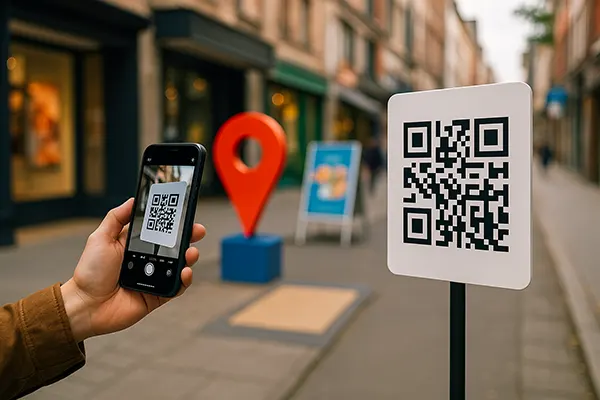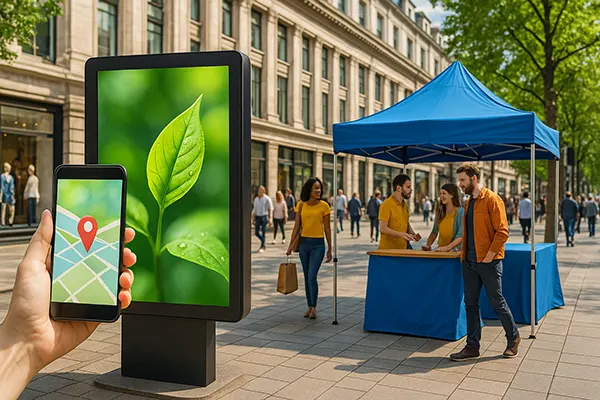Offline Marketing 2.0: QR Codes, Geomarketing and Microlocal Campaigns

As digital advertising becomes saturated and consumer attention fragmented, the rebirth of offline marketing has taken shape in unexpected ways. Marketers are no longer viewing billboards, flyers or in-store displays as static, isolated tactics. Instead, they are merging physical environments with real-time data to engage customers on a new level. This evolution has led to the emergence of Offline Marketing 2.0 — a strategy powered by QR codes, geomarketing, and highly localised campaigns designed for immediate impact and relevance.
QR Codes as Bridges Between Offline and Online Engagement
In 2025, QR codes have moved far beyond novelty or pandemic utility. They have evolved into efficient tools that link physical interactions to digital ecosystems without the need for downloads or friction. From street posters that direct passers-by to limited-time offers, to packaging that opens product tutorials or AR content, QR codes serve as a bridge between curiosity and conversion.
Retailers are using dynamic QR codes that allow real-time updates without changing the physical display. This is especially valuable for campaigns that span multiple locations or short periods. For example, a cinema chain might update its showtimes or promotions across hundreds of screens using one single linked asset, keeping all content synchronised and relevant.
More significantly, the use of unique QR codes in direct mail campaigns allows brands to track each recipient’s interaction. This shift gives marketers the same precision in attribution and user behaviour insights that was once limited to online-only efforts. Offline no longer means unmeasurable.
Tracking and Personalisation through QR Technology
Personalised QR codes enable brands to serve different experiences depending on the scanned device, location or even time of day. This type of segmentation transforms printed content from a static tool to an interactive one. A coffee shop might print postcards with QR codes that offer a free drink — but only if redeemed during a specific time frame, fostering urgency and engagement.
Meanwhile, integration with CRM tools means businesses can connect scans to user profiles, allowing them to tailor follow-up communication. This redefines offline lead generation as a data-rich experience that fuels omnichannel strategies with behavioural context.
From public events to outdoor media, QR-enabled campaigns also act as silent storytellers. With no need for staff interaction or verbal messaging, they allow customers to explore brand narratives at their own pace — whether it’s watching a behind-the-scenes video or accessing a discount before purchase.
Geomarketing: Precision Advertising by Physical Location
Geomarketing in 2025 is more than sending SMS messages to nearby users. With the proliferation of mobile GPS accuracy and consent-based data tracking, marketers can pinpoint when and where a user is likely to convert. Supermarkets, for instance, run hyper-localised promotions that activate once a customer enters a particular aisle or shelf proximity.
This form of targeting allows offline strategies to adopt the retargeting logic of digital marketing. A customer who visited a car showroom but didn’t purchase can be served follow-up deals via digital signage on their daily commute. These insights close the loop between foot traffic and purchase intent, enhancing ROI predictability.
Retailers also use geomarketing to shift foot traffic between branches based on real-time metrics. If one location has a surplus of stock or lagging sales, an instant mobile ad can be pushed to nearby audiences, encouraging spontaneous visits and balancing inventory at the hyperlocal level.
Integrating Offline Campaigns into the Consumer Journey
One of the most critical advances is embedding offline triggers into the consumer journey. Geofences can initiate app notifications, loyalty offers or NFC activations as soon as users cross into a defined area. These real-world entry points act like landing pages, contextualising the brand message based on a consumer’s physical behaviour.
Event marketing has also embraced geomarketing by using location-aware wristbands or badges that personalise the attendee experience. A conference delegate may be guided to specific booths or receive content suggestions depending on which zones they’ve entered.
Importantly, these interactions are not limited to promotions. Brands use them to educate, survey, or even entertain customers. As a result, physical presence becomes not just a moment of exposure, but an entry into deeper brand relationships.

Microlocal Campaigns: The Future of Community-Centric Marketing
Microlocal marketing focuses on serving messages and offers not just to cities or districts, but to blocks, buildings and micro-communities. In 2025, this tactic is central to neighbourhood stores, event venues, or pop-up locations that thrive on proximity-driven engagement and local relevance.
For example, independent bookstores or cafés partner with local influencers to create QR-based treasure hunts, with geotagged social content leading visitors from one location to the next. These campaigns foster not only brand awareness, but also social and communal value, making marketing a participatory experience.
In rural or low-density areas, microlocal tactics allow businesses to hyper-target audiences that would otherwise be overlooked by larger-scale media buys. This shift brings inclusivity to offline marketing, giving even small towns access to big-brand experiences tailored to their daily rhythms and landmarks.
Hyper-Relevance through Local Context
Successful microlocal campaigns rely heavily on understanding cultural, seasonal and behavioural nuances. A fitness brand might sponsor morning bootcamps in a local park, offering QR codes for free samples or exclusive class access. These initiatives blend seamlessly into the lives of the audience rather than interrupting them.
Neighbourhood-specific loyalty schemes also take centre stage. For instance, a grocer might offer different rewards to shoppers based on the residential block they scan from, using QR codes on mailers, receipts or reusable bags. These micro-rewards create habit-forming engagement loops within communities.
As cities grow more segmented in lifestyle and demographic patterns, tailoring offline messages down to the postcode or street level enables marketing to feel more like a conversation and less like a broadcast. This is the ethos of Offline Marketing 2.0 — where physical space becomes a medium for precision storytelling.
